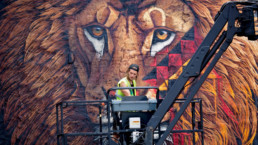In 2017 Sonny launched his To The Bone project with a global mural tour that brought some of the world’s most iconic and endangered animals into urban environments around the world. Making an impact both on the streets and in the media, the large-scale murals honoured the true beauty of these animals, while encouraging people to protect them for future generations.
Over the next year, Sonny painted ten large-scale murals of endangered species in seven countries around the globe including far-reaching locations from New York to Vladivostok, Johannesburg to London. Starting important conversations both offline and online, the true significance of the art spanned far beyond spray paint on brick.
The artist’s creative vision was largely self-funded but also received support from wildlife organisations such as the International Foundation for Animal Welfare (IFAW), Far Eastern Leopards, and Discovery’s Project C.A.T.
The street art tour ended in New York in May of 2018, with a final mural and the opening of Sonny’s first and highly-anticipated solo exhibition of his canvas work, along with a series of hand-painted skull sculptures. The sell-out show explored the precarious balancing act that exists between mankind and the animal kingdom.
The Exhibition
Bringing us face-to-face with a wild world on the brink of extinction
The exhibition was made up of a series of ten mugshot-style paintings of endangered species from around the world. The animals’ faces break away to reveal raw skeletons underneath, a symbol of how their numbers are quickly fading. Ethnic patterns from the animals’ home country adorn the exposed bones, driving home the message that in losing them we’re losing a part of ourselves too.
At the end of the project Sonny donated a total of $15,500 (a percentage of exhibition sales) to Project C.A.T., to support their work towards doubling the number of tigers in the wild by 2022.
The initiative is a collaboration between Discovery Communications and World Wildlife Fund (WWF) that aims to ensure a healthy habitat for future generations of tigers by helping conserve nearly two million acres of protected land in India and Bhutan.














